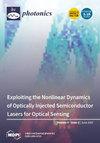Stability Improvement of the TDLAS-Based CO Monitoring Module in a Coal Mine by Using a Spectral Denoising Algorithm Based on SVR
IF 1.9
4区 物理与天体物理
Q2 OPTICS
引用次数: 0
Abstract
CO gas is not only lethal but also a significant forecasting indicator for the spontaneous combustion of coal mines. It is imperative that monitoring modules for CO gas that work well in the coal mine environment are available. A feasible solution is the detection of CO by using monitoring modules based on tunable diode laser absorption spectroscopy (TDLAS) over a mid-infrared waveband near 4.6 μm. However, in most cases, the mid-infrared TDLAS-based CO monitoring module tends to introduce severe interference fringe noise into the TDLAS spectral backgrounds which is difficult to filter out using traditional spectral filtering methods, reducing the detection performance of the module. In order to filter out the noise and improve the stability of the module in complex coal mine environments, this work proposed an algorithm based on support vector regression (SVR) to extract the TDLAS spectral backgrounds. Spectral analysis indicates that the TDLAS spectral background can be predicted over the entire scanning spectrum range by using this algorithm, and the noise in the spectral background can be effectively filtered out when calculating the absorbance spectrum based on the Lambert–Beer law. Compared to extracting spectral backgrounds using the traditional least square polynomial fit, the obtained correlation coefficients between regression models of spectral backgrounds and corresponding training point datasets were increased from below 0.998 to above 0.999. The peak-to-peak value of the obtained N2 absorbance spectrum was suppressed below 0.022 from nearly 0.045. The signal-to-noise ratio of the obtained 25 ppm CO absorbance spectrum was increased to 13.35 from 6.95. A CO monitoring module polluted by dust was used to conduct experiments to further test the SVR-based algorithm. The experiment results showed that after programming the SVR-based algorithm to the module, the estimated limit of detection of the module was reduced to 5.46 ppm from 29.08 ppm, and all the absolute measuring errors of the standard CO gases with different low concentrations were reduced to less than 4 ppm from a majority of the errors of more than 10 ppm, compared to least square polynomial fit. The CO monitoring module could still maintain the performance of high-precision quantitative detection when using the SVR-based algorithm even if it had been polluted severely. So, the CO monitoring module has good adaptability to harsh field environments, and its operation stability can be effectively improved by using the algorithm proposed in this work.使用基于 SVR 的频谱去噪算法提高煤矿中基于 TDLAS 的一氧化碳监测模块的稳定性
一氧化碳气体不仅致命,还是煤矿自燃的重要预报指标。当务之急是提供能在煤矿环境中正常工作的 CO 气体监测模块。一个可行的解决方案是使用基于可调谐二极管激光吸收光谱(TDLAS)的监测模块,在 4.6 μm 附近的中红外波段上检测 CO。然而,在大多数情况下,基于中红外 TDLAS 的一氧化碳监测模块往往会在 TDLAS 光谱背景中引入严重的干扰条纹噪声,而传统的光谱过滤方法很难将其滤除,从而降低了模块的检测性能。为了滤除噪声,提高模块在复杂煤矿环境中的稳定性,本研究提出了一种基于支持向量回归(SVR)的算法来提取 TDLAS 光谱背景。光谱分析表明,使用该算法可以预测整个扫描光谱范围内的 TDLAS 光谱背景,并且在基于朗伯-比尔定律计算吸光度光谱时,可以有效过滤掉光谱背景中的噪声。与使用传统最小平方多项式拟合法提取光谱背景相比,所获得的光谱背景回归模型与相应训练点数据集之间的相关系数从 0.998 以下提高到 0.999 以上。获得的 N2 吸光度光谱的峰峰值从接近 0.045 下降到 0.022 以下。获得的 25 ppm CO 吸光度光谱的信噪比从 6.95 提高到 13.35。为了进一步测试基于 SVR 的算法,我们使用了一个受粉尘污染的 CO 监测模块进行实验。实验结果表明,在对模块进行基于 SVR 的算法编程后,模块的估计检出限从 29.08 ppm 降至 5.46 ppm,与最小平方多项式拟合相比,不同低浓度 CO 标准气体的绝对测量误差从大多数误差超过 10 ppm 降至 4 ppm 以下。一氧化碳监测模块在使用基于 SVR 的算法时,即使受到严重污染,仍能保持高精度定量检测的性能。因此,一氧化碳监测模块对恶劣的现场环境有很好的适应性,使用本文提出的算法可以有效提高其运行稳定性。
本文章由计算机程序翻译,如有差异,请以英文原文为准。
求助全文
约1分钟内获得全文
求助全文
来源期刊

Photonics
Physics and Astronomy-Instrumentation
CiteScore
2.60
自引率
20.80%
发文量
817
审稿时长
8 weeks
期刊介绍:
Photonics (ISSN 2304-6732) aims at a fast turn around time for peer-reviewing manuscripts and producing accepted articles. The online-only and open access nature of the journal will allow for a speedy and wide circulation of your research as well as review articles. We aim at establishing Photonics as a leading venue for publishing high impact fundamental research but also applications of optics and photonics. The journal particularly welcomes both theoretical (simulation) and experimental research. Our aim is to encourage scientists to publish their experimental and theoretical results in as much detail as possible. There is no restriction on the length of the papers. The full experimental details must be provided so that the results can be reproduced. Electronic files and software regarding the full details of the calculation and experimental procedure, if unable to be published in a normal way, can be deposited as supplementary material.
 求助内容:
求助内容: 应助结果提醒方式:
应助结果提醒方式:


